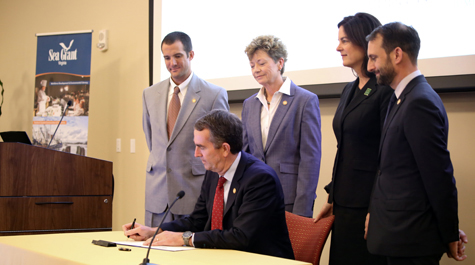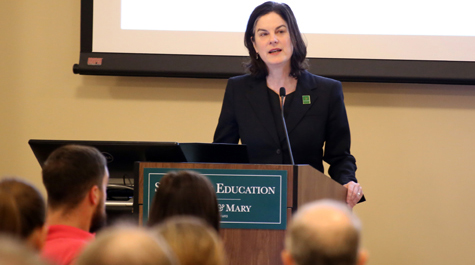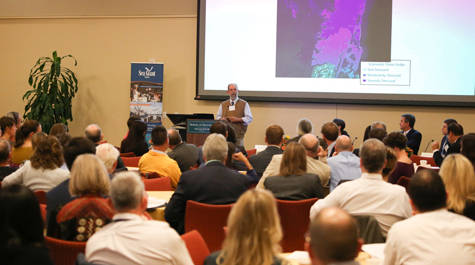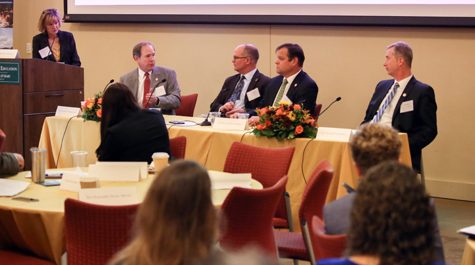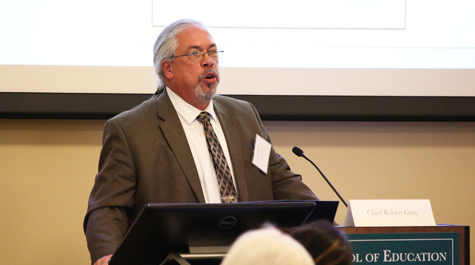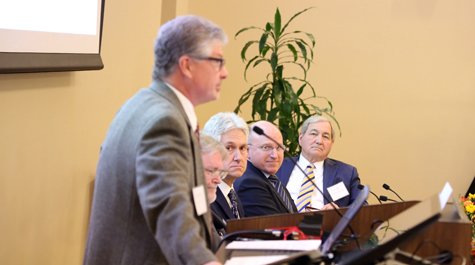Coastal Policy Conference highlights collaboration
Governor's executive order calls on VIMS to help increase flooding resiliency
If there was one underlying current to William & Mary Law School’s sixth annual Virginia Coastal Policy Center (VCPC) Conference on “Building a Resilient Virginia,” it was collaboration. Attendees came from far and wide and were ready to roll up their sleeves, share best ideas and get to work.
“This room knows the urgency of the conversation that we’re engaging in today,” said William & Mary President Katherine A. Rowe during opening remarks. “Rising sea levels and storms pose severe threats to Virginia’s coastal communities, and that means to everything that we do, to our economy, to every aspect of our community. These problems are not going to be solved by one group alone, and we all have an incredibly important part to play.”
Elizabeth Andrews, director of the VCPC, promised “an exciting, jam-packed day,” and more than delivered.
“VCPC’s annual conference has become known as a premier opportunity for policy makers to come together to address the challenges facing our coastal communities, including sea level rise and recurrent flooding. We are excited to continue that tradition this year by bringing together key stakeholders, from government officials to scholars, non-profit representatives and business leaders,” Andrews said. “And we are very honored to host the Governor and such an important event for the Commonwealth.”
Among the groups present during the Nov. 2 event were experts from William & Mary’s Virginia Institute of Marine Science (VIMS), Virginia Sea Grant, coastal planning district commissions, nonprofit organizations, legislators, the Pamunkey tribe and several groups from Louisiana. Virginia Gov. Ralph Northam capped off the day with a keynote address and by signing an executive order that calls on VIMS to leverage its long-term monitoring programs and expertise in flood forecasting to further increase the Commonwealth’s resilience to sea-level rise and natural hazards.
“We’re heartened to see the governor’s call for VIMS to use its cutting-edge modeling capabilities and decades of bay data to help increase Virginia’s resiliency to sea-level rise and coastal flooding,” said VIMS Dean and Director John Wells. “We have a lot to bring to the table and are eager to contribute.”
The morning was kicked off when Andrews introduced Rear Admiral Ann Phillips, the Governor’s new Special Assistant for Coastal Adaptation and Protection, who gave a keynote address on coastal adaptation and protection efforts. Phillips outlined five core tenets consistent with states, coasts, and nations dealing with rising waters, including setting constant standards; getting common access to data on sea level rise; and developing a common understanding of what critical infrastructure is vulnerable to recurrent flooding.
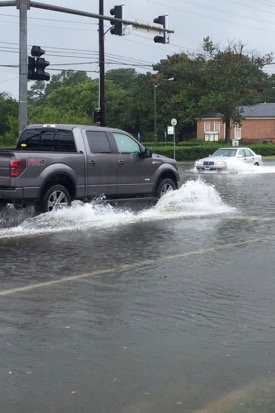 Panels then featured discussions about building resilience for Virginia’s green and gray infrastructure, followed by a legislative panel composed of Senator Monty Mason and Delegates David Bulova, Keith Hodges and Christopher Stolle discussing legislative options for building resilience in the state. Continuing the resilience theme, the lunchtime keynote saw Chief Robert Gray of the Pamunkey Tribe and Dr. Ashley Spivey, Director of the Pamunkey Tribal Research Center, talk about “The Pamunkey as Partners in Resilience.” They provided attendees with an engaging history of the tribe and their cultural emphasis on natural resources.
Panels then featured discussions about building resilience for Virginia’s green and gray infrastructure, followed by a legislative panel composed of Senator Monty Mason and Delegates David Bulova, Keith Hodges and Christopher Stolle discussing legislative options for building resilience in the state. Continuing the resilience theme, the lunchtime keynote saw Chief Robert Gray of the Pamunkey Tribe and Dr. Ashley Spivey, Director of the Pamunkey Tribal Research Center, talk about “The Pamunkey as Partners in Resilience.” They provided attendees with an engaging history of the tribe and their cultural emphasis on natural resources.
In the afternoon, attendees heard from representatives of organizations involved in creating a water management economy in Louisiana, and how such an effort could be pursued in Virginia. Panelists included representatives of the Baton Rouge Area Foundation, LSU Coastal Sustainability Studio, and “The Water Campus,” a collaborative research campus in Baton Rouge that focuses on coastal restoration and sustainability. A final panel explored the economic benefits to Virginia of land conservation and ecotourism.
Governor’s keynote
Capping off the day was a closing keynote address by Governor Ralph Northam, discussing the resilience initiatives of his administration.
“While the challenges we face are daunting, I am excited for the opportunities we have to work together and put ideas into practice,” Northam said.
The governor then put words into action, signing a sweeping executive order to bolster Virginia’s resilience to sea-level rise and natural hazards. Executive Order Twenty-Four lays out a series of actions the Commonwealth will undertake to limit the impacts of flooding, extreme weather events and wildfires.
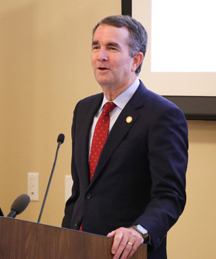 The executive order is among the most comprehensive actions undertaken by any state to improve resilience and protect people and property from natural catastrophes. Significantly, the executive order directs the development of a Virginia “Coastal Resilience Master Plan” to protect the Virginia coastline from sea-level rise and extreme weather.
The executive order is among the most comprehensive actions undertaken by any state to improve resilience and protect people and property from natural catastrophes. Significantly, the executive order directs the development of a Virginia “Coastal Resilience Master Plan” to protect the Virginia coastline from sea-level rise and extreme weather.
“As extreme weather events become more frequent and more intense, the safety and economic well-being of every Virginian is put at greater risk,” Northam said. “The actions the Commonwealth will undertake as a result of this executive order will ensure we address this growing challenge head on, setting Virginia on a path towards resilience to near and long-term natural catastrophes and enhancing our public health and economic vitality with a whole-of-government approach.”
The governor’s signing of the executive order drew a very positive response from the attendees at the conference.
“This is an important step for the Commonwealth, focusing the efforts of various state agencies on developing a planned, statewide response to sea level rise and flooding from storms. This approach will highlight what we can do today to address these threats, and what additional authorities may still be needed,” Andrews noted.
Carl Hershner, director of the Center for Coastal Resources Management at VIMS, said he was encouraged that the order calls actions that use natural and nature-based solutions whenever and wherever possible.
CCRM was at the forefront of a multi-decade effort that ultimately led Virginia’s General Assembly to enshrine one such solution — “living shorelines” — as the preferred technique for stabilizing the Commonwealth’s tidal shorelines.
The order — on a fast track that requires most of its directives to be completed within 180 days — calls on guidance from VIMS in four separate areas. Leading the statewide effort is the Commonwealth’s newly designated chief resilience officer” Secretary of Natural Resources Matt Strickler, a 2007 graduate of VIMS and the Thomas Jefferson Program in Public Policy at W&M.
As evidence of the pervasive threat that sea-level rise poses to Virginia and the nation, the executive order directs Strickler to consult not only with VIMS and the Commonwealth Center for Recurrent Flooding Resiliency, but with offices throughout state government — including the Secretaries of Administration, Commerce and Trade, Finance and Transportation. The consultation also extends to local government; federal partners such as the Departments of Defense, Transportation, Agriculture, Interior and Housing and Urban Development; and non-governmental groups including civic organizations, businesses and non-profits.
VIMS directives
The executive order’s first VIMS-related directive is for agreement on a unified projection of sea-level rise for use in the design, siting, and construction of state-owned buildings beginning on or after Jan. 1, 2020.
“This will ensure that all new state-financed construction follows a consistent, science-based sea-level standard that minimizes its vulnerability to coastal flooding,” said Mark Luckenbach, associate dean of research and advisory services.
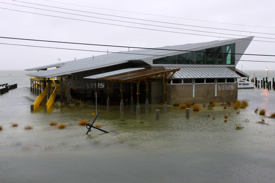 VIMS is well-positioned to assist in this directive, having already created “Sea Level Report Cards” that forecast water levels for Norfolk and 31 other coastal localities to the year 2050; an interactive data graph that compares VIMS’ 2050 sea-level projection for Norfolk with forecasts provided by NOAA and the Army Corps of Engineers; and the first major study of recurrent coastal flooding in Tidewater Virginia.
VIMS is well-positioned to assist in this directive, having already created “Sea Level Report Cards” that forecast water levels for Norfolk and 31 other coastal localities to the year 2050; an interactive data graph that compares VIMS’ 2050 sea-level projection for Norfolk with forecasts provided by NOAA and the Army Corps of Engineers; and the first major study of recurrent coastal flooding in Tidewater Virginia.
A second directive is to establish a “freeboard” standard for state-owned buildings, again with an implementation date for projects slated to begin in 2020 or later. Freeboard is the height of a building’s lowest floor above a given flood level. VIMS, with access to highly accurate, LIDAR-based elevation maps and operation of its own Tidewatch network and high-resolution flood models, is uniquely positioned to help determine the most effective freeboard standard for coastal Virginia localities.
A third directive — closely related to the first two — is to work collaboratively with local governments to ensure that the statewide sea-level projection and freeboard standards are useful for local decision-making. VIMS is again ahead of the curve here, with its Comprehensive Coastal Resource Management Portals, which provide guidance on shoreline management tailored to each of the 45 cities and counties that make up Tidewater Virginia. The institute also brings decades of advisory service experience with these cities and counties, as well as with regional planning district commissions, wetlands boards, and other local stakeholders.
The executive order’s Virginia Coastal Resilience Master Plan will identify the most effective tools, techniques and programs for reducing the impacts of tidal and storm-surge flooding. This comprehensive plan, with input from VIMS and scores of other partners, will first identify all ongoing, planned, and proposed federal, state, and local projects to reduce flooding and flood risk; then “provide recommendations for additional hazard-mitigation, flood-control, and adaptation projects to fill in gaps and improve the preparedness and resilience of the entire coastal area of Virginia for flooding and sea-level rise.” The AdaptVA website, a collaboration between VIMS and the Virginia Coastal Policy Center, provides a step forward on both goals.
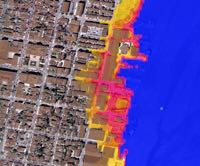 Hershner, with nearly 40 years of providing advisory service on coastal issues in Virginia, says the executive order hits all the right notes.
Hershner, with nearly 40 years of providing advisory service on coastal issues in Virginia, says the executive order hits all the right notes.
“It’s encouraging to have such a clear acknowledgement of the threat that rising seas pose to Virginia’s people, economy, and environment,” he said. “And I’m really glad to see an emphasis on the fact that efforts to increase Virginia’s resiliency to sea-level rise should be based on the best available science.”
Rowe said that the challenges Virginia faces are of such complexity that they will require sustained collaboration of the kind that the VCPC has cultivated for a number of years.
“Today’s conference, to me, illustrates the incredible power of collaboration across sectors and disciplines,” Rowe said. “Partnerships between government, higher education, the military and the private sector strengthen our shared interests; they are critical to solving the problem of coastal stability.” Skip to main content
Skip to main content

